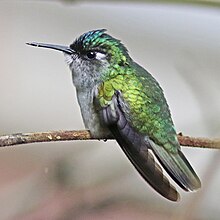Trochilinae is one of the six subfamilies that make up the hummingbird family Trochilidae.
| Trochilinae | |
|---|---|

| |
| Female violet-headed hummingbird (Klais guimeti) | |
| Scientific classification | |
| Domain: | Eukaryota |
| Kingdom: | Animalia |
| Phylum: | Chordata |
| Class: | Aves |
| Clade: | Strisores |
| Order: | Apodiformes |
| Family: | Trochilidae |
| Subfamily: | Trochilinae Reichenbach, 1854 |
| Tribes | |
|
3, see text | |
The subfamily is divided into three tribes: Lampornithini (mountain gems) containing 18 species, Mellisugini (bees) containing 37 species and Trochilini (emeralds) containing 115 species.[1][2]
Phylogeny
editThe hummingbirds were formerly divided into two subfamilies, the hermits (Phaethornithinae) and the nonhermits (Trochilinae). The results from a 2007 DNA hybridization study suggested that the hermits were basal to the rest of the family.[3]
A molecular phylogenetic study of the hummingbirds published in 2007 found that the family consisted of nine clades.[4] When Edward Dickinson and James Van Remsen Jr. updated the Howard and Moore Complete Checklist of the Birds of the World for the 4th edition in 2013, they divided the hummingbird family into six subfamilies based on the molecular results and redefined the subfamily Trochilinae to contain three clades, each of which they placed in a separate tribe: Lampornithini (mountain gems), Mellisugini (bees) and Trochilini (emeralds).[5] A comprehensive phylogenetic study that sampled 284 hummingbird species was published in 2014. It confirmed the nine clades found in the earlier study but found that the hermits were sister to the topazes clade (subfamily Florisuginae) containing the genera Topaza and Florisuga. Many of the traditional genera in the emerald clade (Trochilini) were shown to be polyphyletic.[1] As a result, many of the genera in this part of the tree have been revised.[2][6]
| Trochilidae |
| ||||||||||||||||||||||||||||||||||||||||||||||||
The above cladogram of the hummingbird family is based on a molecular phylogenetic study by Jimmy McGuire and collaborators published in 2014.[1] The Latin names are those proposed by Dickinson and Remsen in 2013.[7]
References
edit- ^ a b c McGuire, J.; Witt, C.; Remsen, J.V.; Corl, A.; Rabosky, D.; Altshuler, D.; Dudley, R. (2014). "Molecular phylogenetics and the diversification of hummingbirds". Current Biology. 24 (8): 910–916. Bibcode:2014CBio...24..910M. doi:10.1016/j.cub.2014.03.016. PMID 24704078.
- ^ a b Gill, Frank; Donsker, David; Rasmussen, Pamela, eds. (January 2021). "Hummingbirds". IOC World Bird List Version 11.1. International Ornithologists' Union. Retrieved 25 January 2021.
- ^ Bleiweiss, R.; Kirsch, J.A.; Matheus, J.C. (1997). "DNA hybridization evidence for the principal lineages of hummingbirds (Aves:Trochilidae)". Molecular Biology and Evolution. 14 (3): 325–343. doi:10.1093/oxfordjournals.molbev.a025767. PMID 9066799.
- ^ McGuire, J.A.; Witt, C.C.; Altshuler, D.L.; Remsen, J.V. (2007). "Phylogenetic systematics and biogeography of hummingbirds: Bayesian and maximum likelihood analyses of partitioned data and selection of an appropriate partitioning strategy". Systematic Biology. 56 (5): 837–856. doi:10.1080/10635150701656360. PMID 17934998.
- ^ Dickinson & Remsen 2013, p. 111.
- ^ Stiles, F.G.; Remsen, J.V. Jr.; Mcguire, J.A. (2017). "The generic classification of the Trochilini (Aves: Trochilidae): Reconciling taxonomy with phylogeny". Zootaxa. 4353 (3): 401–424. doi:10.11646/zootaxa.4353.3. PMID 29245495.
- ^ Dickinson & Remsen 2013, pp. 105–136.
Sources
edit- Dickinson, E.C.; Remsen, J.V. Jr., eds. (2013). The Howard & Moore Complete Checklist of the Birds of the World. Vol. 1: Non-passerines (4th ed.). Eastbourne, UK: Aves Press. ISBN 978-0-9568611-0-8.